How can you plant a pear?
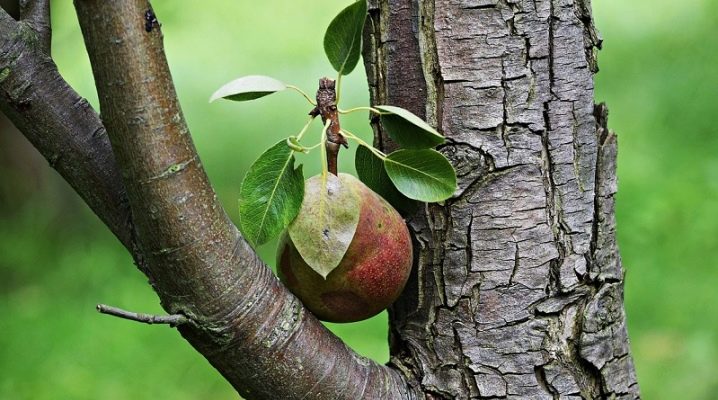
Today it is easier than ever not to buy an expensive pear seedling of the desired variety, but to purchase a cutting from the nursery. It will be cheaper, and with the help of grafting, you can save space on the site, especially since the rootstock will definitely be found in the garden, since a pear can be grafted onto many trees, including an apple tree.
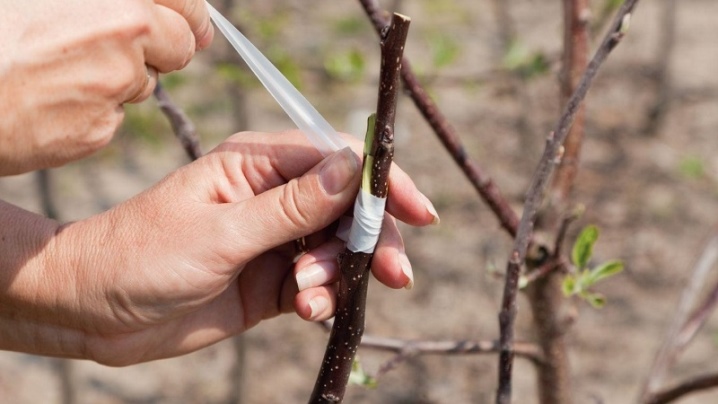
The need for a procedure
Grafting is understood as the introduction of a living part of one plant into another. The stalk that is implanted into the tree is called the scion, and the stock is the tree on which the grafting is done. If the gardener wants to give the tree new varietal qualities, then, for example, a pear can be grafted. Fruit trees propagate by cuttings simply, it is enough just to study the technology in more detail. In addition, grafting is done to increase the yield of the tree, giving it early maturity. Thanks to her, you can qualitatively improve the taste of the fruit and the presentation. Moreover, grafted pears give several different fruits, as a result of which it is possible to save territory on the site.
Through this method, they domesticate the wild, experiment with new varieties and even increase the resistance of the tree to pests. Vaccination helps to rejuvenate the old pear, with its help they form the crown in the necessary way and even breed new varieties or rare ones.
As practice shows, with the help of grafting, it is possible to achieve the growth of a new plant, which will have better qualities than the stock. Thus, decorative and dwarf pears are formed.
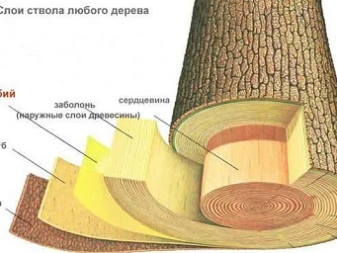

Terms of vaccination
In the Moscow region, in Siberia, in the middle lane and other regions of our country, the success of the vaccination will depend on when it was given. Spring is the ideal time for beginners to learn to master the process of grafting fruit trees.
If the vaccination has not taken root in the spring, then it can be repeated in the middle or at the end of summer, in extreme cases - at the beginning of autumn, but the latter option is available only for the southern regions of our country. In spring, April is considered a favorable time, in summer - early July.
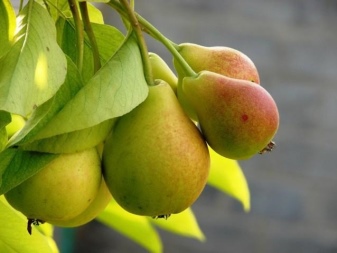

Spring
Experts agree that this is the perfect time. It is worth carrying out all the activities before the sap flow begins. The bark separates easily during the indicated period, therefore, it is much easier to plant an adult pear. Air temperature is important, since cuttings are highly sensitive to fluctuations day and night.... In the spring months as soon as at night the temperature stops dropping below 0 ° С, and during the day it rises to at least + 10 ° С, the kidneys swell, it's time for vaccinations.
Particular attention should be paid to the bark with a cambial layer, since it is considered a prerequisite that it separates well. It is not difficult to check this, you just need to slightly move the bark with the tip of a knife. If it leaves easily, you can start the procedure, and this damage is covered up with garden pitch. One of the advantages of pear grafting in the spring is the rapid subsequent growth of the scion.
It also happens that after a few months it becomes clear that the result of the vaccination is negative. In this case, you can repeat the procedure in the summer in August.
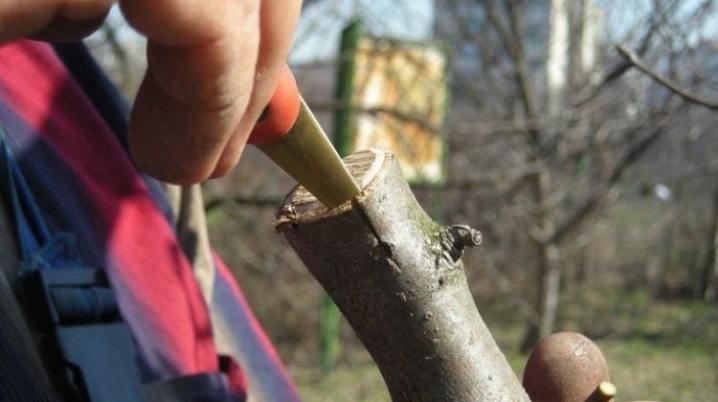
Summer
Summer vaccination is done in the event that it was missed in the spring or the result was unsuccessful... During this period, the second stage of sap flow occurs, the bark becomes soft again. It demonstrates the necessary elasticity. The best period is from July to August.
And the summer vaccination has its advantages - the scion does not need to be prepared and stored. There is still enough time until the end of the season to assess the result of the procedure. But the summer procedure also has one main drawback - heat. It is capable of killing the stalk, so it is best to vaccinate in the evening or early in the morning.
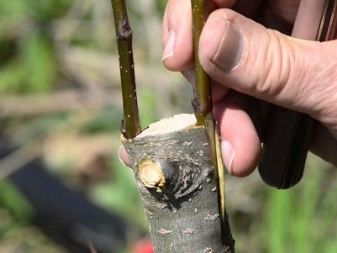
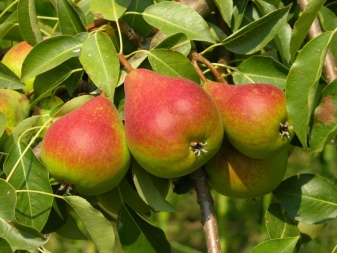
In autumn
Autumn grafting takes place in September. The disadvantage is that most cuttings do not have time to take root, since the time until the first frost is very limited... It is worth taking into account the fact that the incisions made during this period on the rootstock heal for a very long time. If the vaccine is not covered for the winter, it can easily be frostbitten.
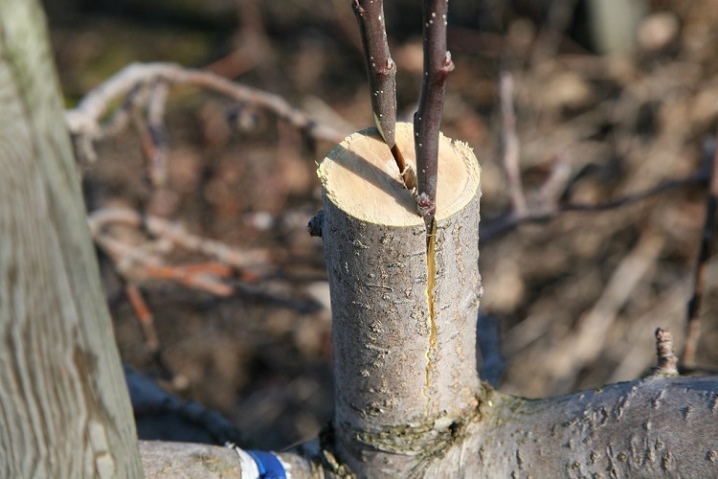
What trees can you graft into?
A pear can be grafted onto many trees:
- to cherries;
- on an ordinary mountain ash;
- on quince;
- on the plum;
- on the apple tree;
- to the wild;
- hawthorn;
- on irgu;
- for another variety of pear.
Often a young pear is grafted onto an old one, thus rejuvenating the garden, and it can bear fruit for many years.
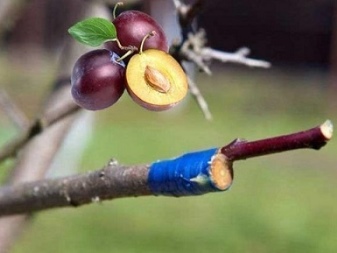

On irgu
It is very important to choose the right stock, since not only the height of the tree will depend on it, but also the period when the plant will begin to bear fruit, as well as the degree of yield. If a game or chokeberry is chosen, then ultimately the tree will be dwarf. Over time, it will be difficult not to notice the difference in thickness between two different trees at the grafting site; after a few years, overflows will appear.
Experienced gardeners say that such trees have no future, their life spans are short, they are low resilience and require support. At the same time, the game is capable of withstanding severe frosts, up to -50 ° C, and it is not demanding on the acidity of the soil.
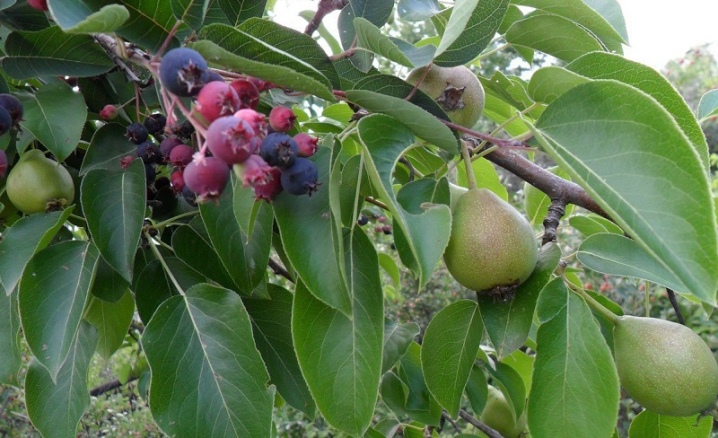
On quince
There are pros and cons of vaccination for quince. For example, trees bear fruit earlier, do not grow large, which makes it easier to collect fruits, but they have low frost resistance, therefore, they are not suitable for the northern regions and the middle lane.
This is one of the most requested options. Thanks to this vaccination, it is possible:
- make the tree smaller;
- reduce the landing area;
- improve the taste of fruits.
Quince is the only tree that can be grafted with an incompatible variety... In order for such a stalk to take root, a compatible variety is grafted in the first year, it will subsequently become the basis for an incompatible variety. There is another option - to be vaccinated for the bark.
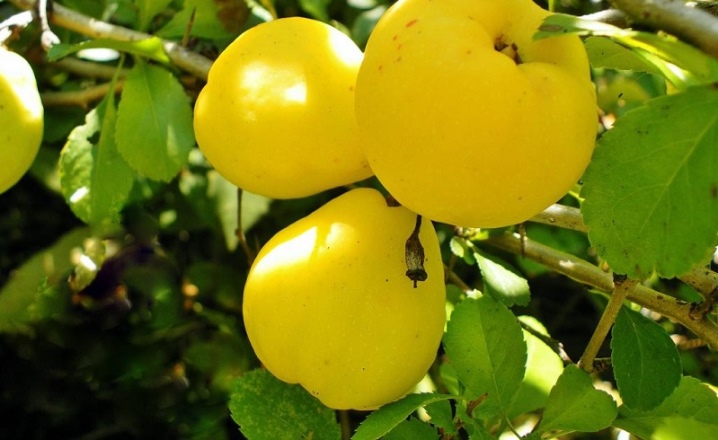
Into the wild
A good stock for a pear is a wild seedling, since it is easily combined with long-cultivated varieties.... The grafting demonstrates excellent healing properties, but is not suitable for the northern and central regions of our country, since such trees do not survive. This method is rarely used in nurseries. The most winter-hardy stock are pears of the Ussuriyskaya variety, grown from seeds.
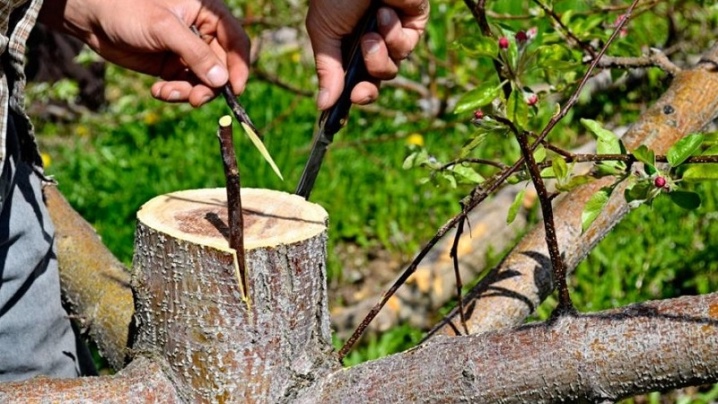
On a mountain ash
It is best to plant late varieties of pears on a rowan seedling. This is a great option if the tree grows in swampy soil. It is convenient to harvest from such a tree, since the crown of the mountain ash is compact. Pears grafted onto this tree have a pleasant tart taste.
In this case, it is advised to form the crown of the tree and leave 1/3 of the branches every year and no more.... So the fruits will receive the necessary nutrients and moisture. An escape that has been grafted will eventually have to be placed on a support, otherwise it may simply break under the weight of pears.
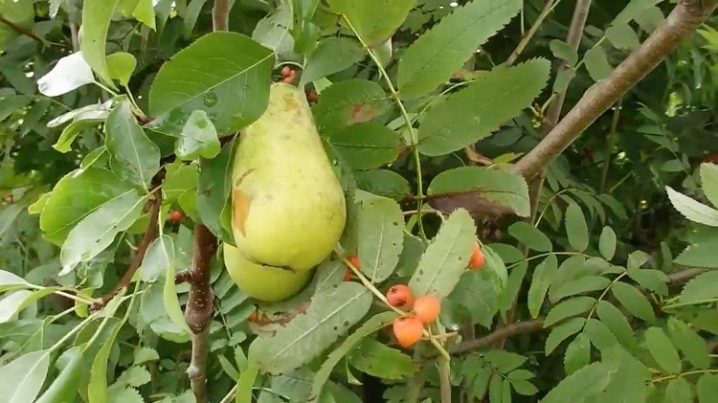
Hawthorn
This tree has an important quality - it perfectly tolerates the absence of rain for a long time. A hybrid of a pear on a hawthorn will thrive on poor, sandy soil, while demonstrating annual fruiting. The only negative is the thorns that interfere with the harvest.
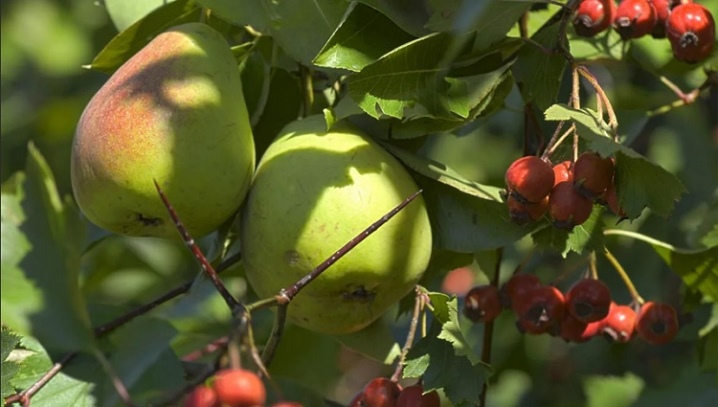
On the plum
Not only plum is suitable, but also cherry plum. If the stalk is prepared correctly, then you are guaranteed a positive result.It is worth preparing such material after the first frost. The resulting plant will be unpretentious, small in size and will delight with early fruits.
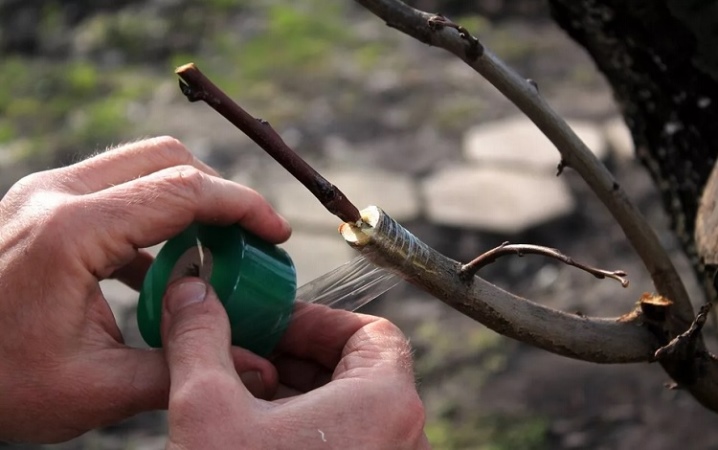
On the apple tree
In the gardens of summer residents, apple and pear trees are more common, they are also quite compatible with each other. The cuttings show good survival, the only drawback is the accretion of wood, so a support is required, otherwise the scion may simply break off. The best results can be achieved in the spring, and it is desirable that the apple tree be grown from seed. Thus, a hybrid with unique qualities is obtained. For inoculation, a T-incision kidney method is used.
Some gardeners say that such hybrids do not live long and after a few years they die off on the tree, while giving a poor harvest.
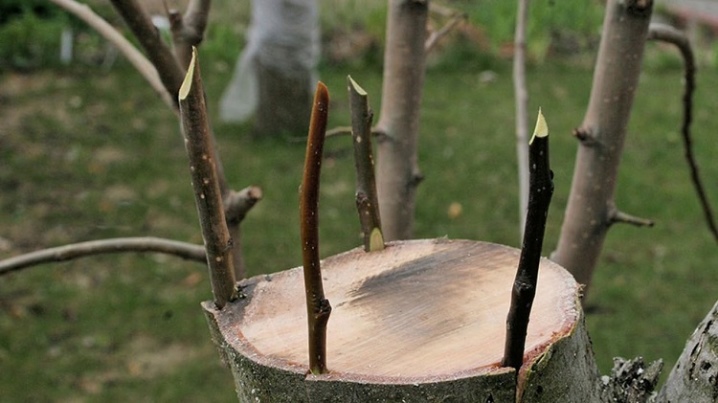
Preparation
Before using the stock, it is necessary to prepare the material and tools that will be required for the work.
Procurement of material
In nurseries, you can easily find the desired scion, sometimes such material is purchased from hand. The subsequent result depends on how high-quality it is and how the gardener prepared it. For the cutting, an annual shoot of a pear is selected, which is separated from the mother tree. It should be selected, taking into account the following features:
- the tip of the shoot, which has grown in the new season, is necessarily selected;
- the bark should be smooth, without damage, intense color;
- on the shoot, it is necessary to look at the growth point, which will be limited by the kidney ring.
Cut the selected stalk under the kidney ring. Cuttings are harvested after the first frost, when the tree has already fallen asleep and the sap flow has stopped. Shoots that are located on the south side of the tree are best suited. The branch should be about 5 mm in diameter and about 30 cm long. It is imperative to assess the quality of the wood, which should be moist and green. A section with 3-5 leaf buds is cut off, the cut is covered with a special tool - garden var.
Inexperienced gardeners do not know how such material is stored in winter. In fact, everything is simple, you need to tie the cuttings in an armful and lay them in a trench, the depth of which is 25 cm. It doesn't matter if they stand vertically or horizontally, soil is poured on top, foliage is laid, or straw can be used. Breathable material is on top of everything, in this case burlap is perfect.
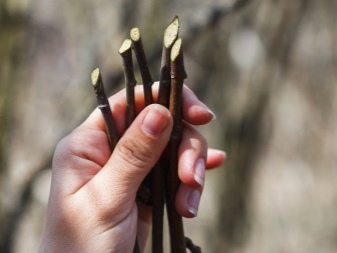

If there is not a lot of material for inoculation, then you can put it in the refrigerator in a simple polyethylene bag. In this case, the cuttings must first be wrapped in a damp cloth. Wet sawdust is also suitable for storage, which should be poured into the box. From time to time, you need to inspect the cuttings and check if putrefactive processes have appeared on them. Storage temperature - 0-4 ° С.
With the onset of spring, the cuttings are taken out, examined, healthy ones are selected, all the rest are thrown away. They will need to make new sections a day before the scheduled vaccination and immerse them for 6 hours in Kornevin, which can be replaced with potassium humate. In the southern part of our country, trees are cut in the spring, before the buds begin to bloom. If the vaccination is done in the summer, then the cutting is cut immediately before the procedure.
The stock will also need to be prepared. The gardener carefully examines the tree and the area where it is planned to plant the cutting. There should be no signs of illness or any other damage, including from insects and rodents. Healthy bark is uniform in color, smooth and glossy. It is best to use a seedling that is from one to 3 years old for grafting a pear.
If grafted onto a skeletal branch, then the tree can be up to 10 years old. However, the escape, where the vaccination will be done, must meet the following requirements:
- looks upright;
- does not change its position.
Such skeletal branches not only show good growth, but also cuttings take root on them faster.
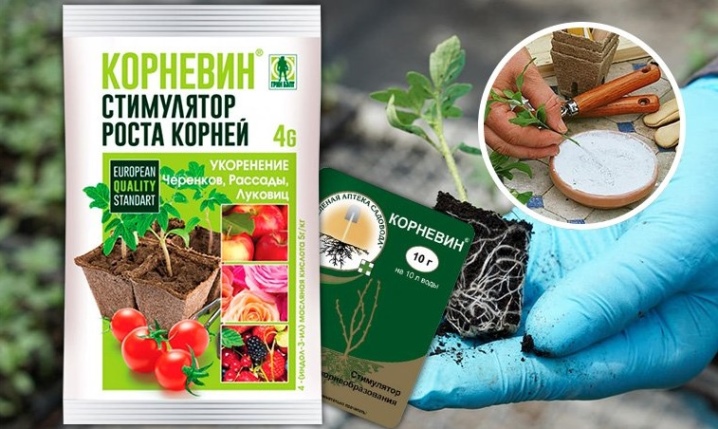
Instruments
Of the tools that a gardener will need, you should prepare:
- garden knife;
- secateurs;
- hacksaw;
- garden pitch;
- foil or paper bag;
- insulation tape.
All instruments must be disinfected before using them. A solution of potassium permanganate, bleach or alcohol is suitable for this. After the procedure, all damage must be covered with garden varnish - a means that is designed to protect against pathogenic microorganisms in places of damage to the bark.
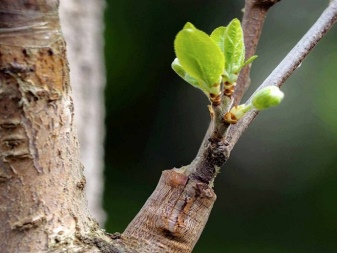

Basic ways
In order for a gardener to plant a pear correctly, he needs instructions, especially in the absence of proper experience. For beginners, this is the only way to achieve a positive result. In each individual case, the gardener decides for himself which method to choose - to be vaccinated on the trunk or on young shoots.
Into the cleft
It is recommended to inoculate in the split when the branches have a lot of damage on the crown, but the roots are still strong enough. In this particular variation, the stock should be thicker than cuttings, whether you are using a wild pear or a domesticated cherry.
Several pear cuttings are grafted onto the sawn branch in the place of the sawn cut. You will need to split the stock crosswise, sharpen the grafting material from below and insert into the split. After that, the entire connection area is fixed with tape and thickly lubricated with garden varnish.
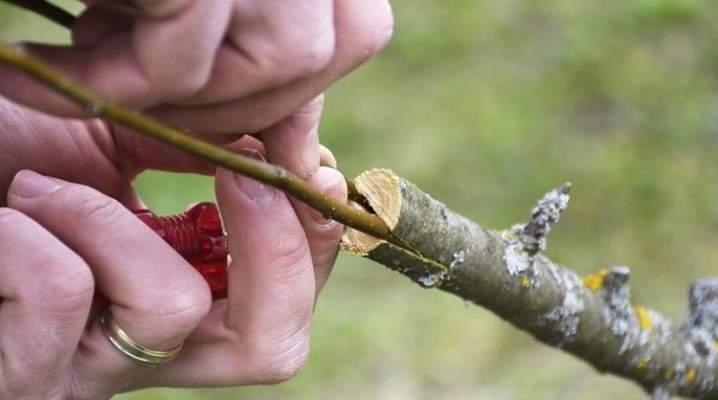
By the kidney
There are two options for eye grafting:
- germinating;
- sleeping.
In the first case, a kidney is taken from the material that was harvested last year in the fall. The stalk will sprout quickly and sprout in the same year when the vaccine is given. It is best to carry out the procedure in the spring. In the second version, the work is carried out in the summer, when the cutting is separated and grown fresh to the tree. It will germinate only in the spring, next year.
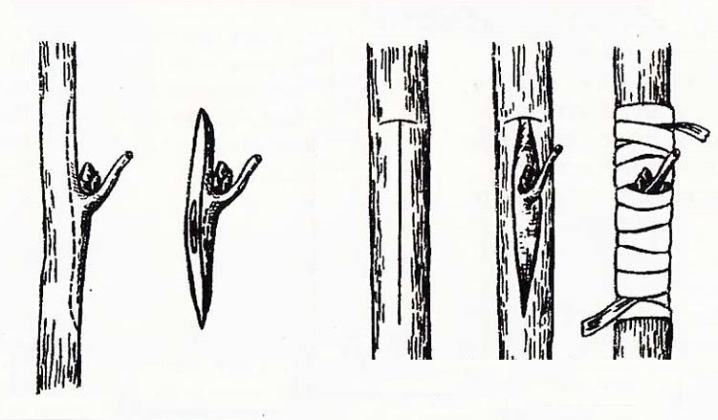
Budding
T-shaped cut
Summer grafting of trees begins at the end of July and lasts until the end of August. The method is applied in most cases to young seedlings. You will need to clear the trunk of branches at a height of 10 cm from the ground. Rinse well with water and wipe with a rag so that it dries faster.
The T-notch is placed as close to the ground as possible. You will need to push the bark with a garden knife, then take the stem of the grafted plant in your left hand. In this case, the index finger must be placed under it on the opposite side of the area that is being cut. At the same time, the eyepiece of the garden knife is placed with the right hand 1-1.5 cm from the kidney. You can cut the bark from top to bottom. The cut should end 1.5 cm lower than the peephole.
When the cut is done, the scutellum is removed in the left hand and inserted into the base of the root stock. Then they squeeze it a little and wrap it tightly with polyethylene or special tape. The petiole and bud should remain free.
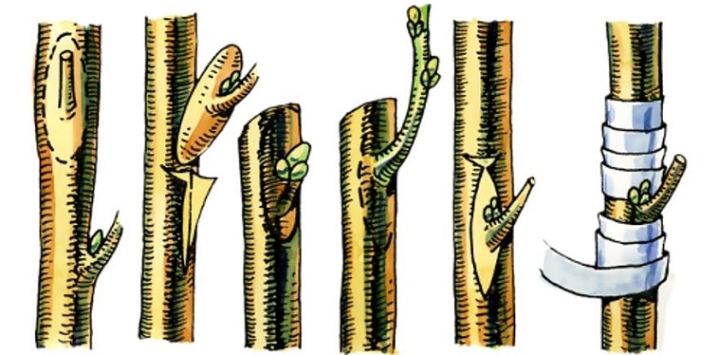
Vpklad
Make a cut on the rootstock, which will correspond in size to that made on the bud. The cambium layers will need to be tightly combined, fixed with tape.
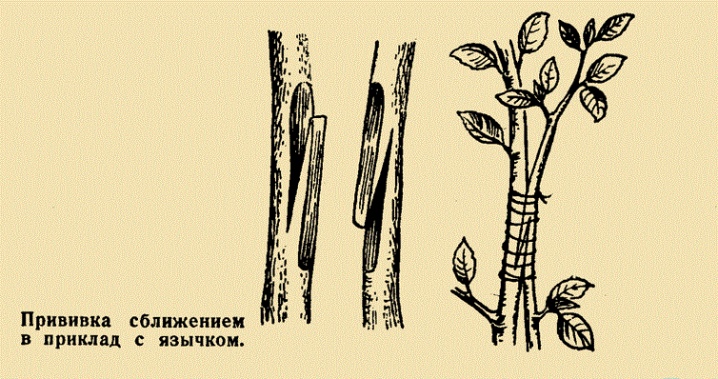
For the bark
This is the simplest pear grafting method and is often used by beginners. You should start in spring, when sap flow is activated, since during this period the bark is perfectly separated, and you do not need to make a large cut.
The sequence is as follows:
- first you need to cut the stem of the stock to the knee and clean the stump with a knife;
- on one side, an incision is made along the bark by 2 centimeters, the direction is from top to bottom;
- a cut is made on the handle and shortened by 5 mm;
- a stalk is inserted into the bark and pushed a little so that it goes inside well;
- the zone is fixed with electrical tape, making sure that the cutting and stock are in good contact with each other;
- everything that is above 3 buds on the handle is cut off.
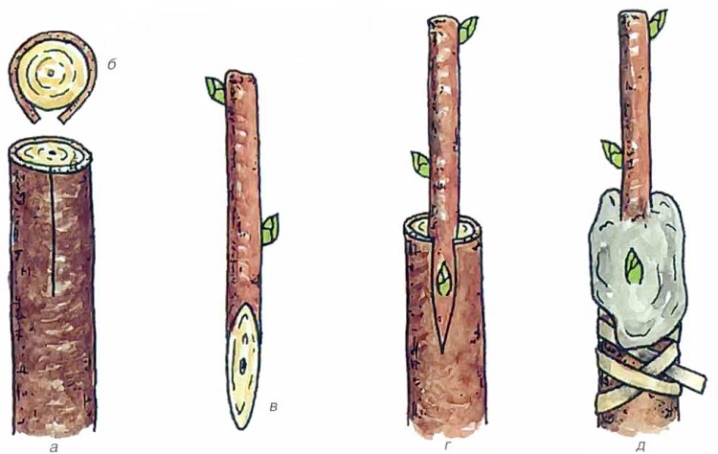
Copulation
This method is used if the tree is young, the branches are not too thick yet. In this version, a prerequisite is the coincidence in the diameter of the cuttings and stock.Using this method, the gardener must pick up a branch on the tree, the diameter of which is as close as possible to that of the cutting. An oblique cut is made with a special sharp garden knife on the scion and rootstock. Then the two plants are connected so that they match as much as possible. The joint is wrapped with a special garden tape.
It also happens that skeletal branches have already formed on the tree, then they are grafted onto the bark with a thorn.

Ablactation
This method is not often used. Its essence is that two connected shoots should grow together over time. In this case, it is very important to ensure tight contact between the scion and the rootstock, otherwise nothing will work.
The sequence of the considered method is as follows.
- The area that will be in contact with another tree must be stripped of bark. This applies to both the scion and the rootstock.
- When the place is prepared, the scion and rootstock are brought together. It is advised to sharpen both with an acute angle, then the contact area will be larger.
- The joint is secured with a garden tape. The harness can be removed after a few months, when the shoots grow well together.
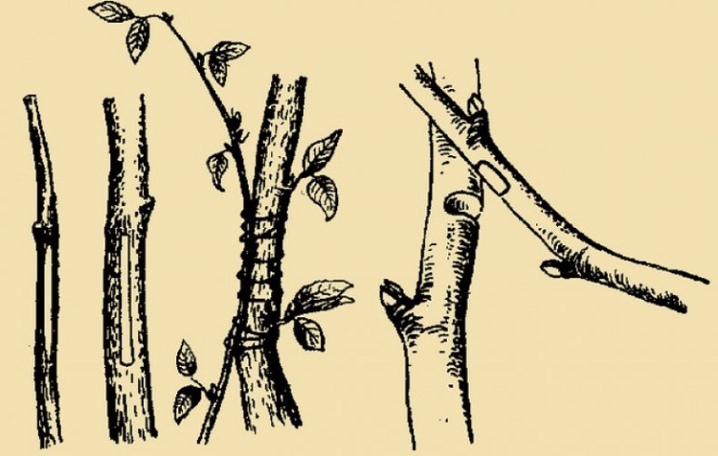
Follow-up care
Tree maintenance is simple. The area around the pear periodically needs to be loosened, weeds removed. Introduce top dressing in a timely manner. In autumn, in order to avoid frostbite and burns from active sunlight, you will need to whitewash the trunk and at the base of the branches, which are called skeletal.
From late autumn, the space around the trunk is mulched. The pear needs to be watered, and it should be done on time. Young trees require high-quality, deep watering 3-4 times during the summer. At the same time, it is necessary to spend up to 6 buckets of water per plant, the seedlings of the first year need less. After each moistening of the soil, it is advisable to mulch the soil around the tree with humus. It not only plays the role of fertilizer, but also retains moisture in the soil. Be sure to water it before the buds bloom, during the period when the fruits begin to set and during early ripening.
It is equally important to form the crown of the tree in time. Pruning is best done in early spring, usually in March, before foliage appears. If the trees are formed on high rootstocks, then it is better to use a sparse-tiered system, when leaving 4-6 branches of the skeletal type. At the same time, it is important that when trimming, the distance between the tiers formed on the crown is observed. It should be between 40 and 60 cm.
The leading branches are shortened. A pear grafted on a quince is formed in the form:
- shrub;
- bowls;
- palmettes.
If a biennial plant is reduced in growth by 10 cm, then rejuvenating pruning is imperative. Sanitization can be carried out at any stage of growth.
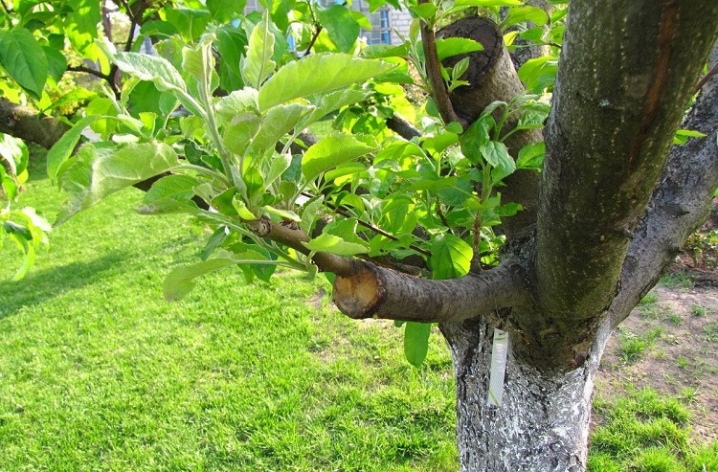






The comment was sent successfully.